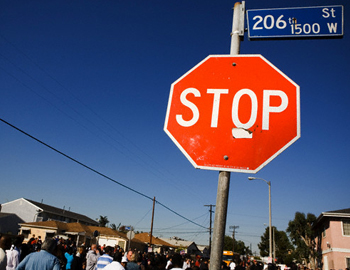Business & Health
The Role of Black and Latino Homeowners in Global Recession
It all started in March when the U.S. stock market suffered its worst one-week performance in years after nervous investors dumped shares in sub-prime mortgage companies over fears that high default rates on home loans and pending federal investigations would cause financial problems for lenders and the economy.
It all started in March when the U.S. stock market suffered its worst one-week performance in years after nervous investors dumped shares in sub-prime mortgage companies over fears that high default rates on home loans and pending federal investigations would cause financial problems for lenders and the economy.
Now, such concerns about the risks in subprime lending have come to fruition as the nation’s financial markets remain in crisis mode. Investors, spooked by losses at mortgage lenders, triggered several rollercoaster weeks on Wall Street this summer through their volatile intraday trading. And with foreclosure rates still on the rise, several mortgage companies have even suspended subprime lending. To stabilize credit markets, the U.S. Federal Reserve, among other things, cut its rate on loans to banks.
Subprime mortgage loans — high-interest loans typically assumed by borrowers with weak or no credit histories — were coveted during the nation’s recent housing boom for enabling those that were traditionally shunned by loan companies to purchase homes.
But as the market cooled, the reality of fluctuating mortgage payments proved too difficult to bear for many defaulted homebuyers. Subprime lending companies soon drew heightened scrutiny for their lending practices and ability to meet investor expectations.
Blacks and Latinos play a key role in the subprime loan market’s health. The Federal Reserve says blacks and Latinos are about three times more likely to receive a subprime loan. And more than half of the subprime loans issued in 2005 were to African Americans, with Latinos receiving 40% of the loans, according to a noted 2006 study by the Center for Responsible Lending.
Based on that loan data, the study projects that 10% of recent African-American homeowners will default on a subprime mortgage and Latinos will default on 8% of their mortgages, compared to 4% of whites.
While the subtleties of subprime loans have long been a concern for lawmakers and fair-lending advocates, the market’s recent struggles have sent new waves through the banking industry. It also triggered calls for regulatory reform by the Federal Reserve, state attorney generals and consumer rights groups.
Congressional hearings have sought to address the issue, with legislation targeting predatory lenders being introduced in federal and state government.
The NAACP and other civil rights groups this year called on mortgage lenders to institute a six-month moratorium on subprime home foreclosures. What’s more, state attorney general offices have launched inquires into why blacks and Latinos borrowers pay more than whites for mortgage loans.
To be sure, not all subprime mortgage companies engage in predatory lending. And with minority home ownership at an all-time high, subprime loans appear to be beneficial to some in that they provide a way for unwanted borrowers to fund their dreams of homeownership.
But despite the benefits, the consequences of defaulting on a subprime loan can be severe for many borrowers, who may face foreclosure, the loss of accumulated home equity and reduced access to credit.
Understanding the Terms
Subprime lending experts say a lack of financial literacy by many blacks and Latinos makes the groups more likely to overlook how the fluctuating interest rates on adjustable-rate loans might affect their monthly payments. And even when borrowers are aware of the subprime dangers, lending experts say the idea of owning a home often trumps the potential risks.
“The pitch is not the interest rate — in fact many people don’t even know their interest rate,” says Ira Goldstein, Director of Public Policy and Program Assessment for community investment group The Reinvestment Fund and a professor at the University of Pennsylvania.
“In many instances people are using mortgage brokers who are steering them (borrowers) to particular products they feel are appropriate for them, or the easiest they feel will get the mortgages approved.”
Prey for Lenders
Government and industry studies show blacks and Latinos are more venerable to predatory lenders, who may, among other things, steer borrowers qualified for more affordable loans to the subprime market where they’ll face hidden fees and higher penalties. A recent study of 167 metropolitan areas by the National Community Reinvestment Coalition found that minority borrowers are at the greatest risk of receiving “poorly underwritten, high-cost loans,” regardless of income. Other studies have found a close relationship between predatory lending and foreclosure.
Goldstein authored a Reinvestment Fund study this year that outlined the extent to which African Americans and Latinos are affected by predatory lending in Philadelphia. After analyzing the sale history of more than 15,000 properties in the city, researchers found that one in every 30 Philadelphia homeowners has been targeted by predatory lending, mostly in African American or Latino neighborhoods.
Many borrowers, Goldstein said, reported that traditional banks felt inaccessible to them for home loans, making blacks and Latinos vulnerable to predatory lenders, who are were more visible in the community. “I think part of it is a history of not feeling as if mainstream financial institutions were available even though they very well may be today,” Goldstein says.
Subprime Rise and Fall
Subprime loans first emerged as an option in home buying two decades ago. In the mid-1990s, the popularity of subprime loans grew rapidly as technology innovations made it easier and cheaper for lenders to assess the pricing risks in credit decisions. The number of subprime loans issued in the U.S. increased to 790,000 from 80,000 between 1993 and 1998, according to the U.S. Housing and Urban Development Department. In 2006, subprime mortgages accounted for 20% of the more than $3 trillion issued for new home loans, compared to 6% in 2002, according to recent study by the financial services firm Credit Suisse.
The Mortgage Banker’s Association, a trade organization that represents real estate finance companies, says economic conditions, and not subprime loans, are the main factor in rising foreclosure rates. For example, Ohio, Michigan, Indiana, Illinois and Wisconsin represent only about 14% of the nation’s outstanding mortgages, but account for 28% of the loans in foreclosure, said MBA Chairman John M. Robbins in a written response to a Congressional report on the issue, noting that subprime borrowers account for about half of the loans in foreclosure in those states.
Robbins said that the loss of more than 700,000 jobs in the region since 2000 has directly affected the foreclosure rate. “It is clearly problems with the economy in this region that are driving the ability of borrowers to repay their mortgages or sell their homes if they get into trouble,” Robbins said in the response.
Preventing Another Crisis
Following the brief stock market scare in March, Congress summoned subprime mortgage lenders and regulators to Washington for hearings that explored how federal banking regulators can ease the crisis and the driving factors of the high default rate among subprime borrowers.
In response to pressure from lawmakers and consumer advocates, regulators recently tightened its oversight on subprime loans, issuing guidelines requiring federally-regulated lenders to consider the borrower’s ability to pay an adjustable-rate mortgage and other factors in loan decisions.
To curb predatory lending, Stephanie Tubbs Jones, an Ohio Democrat, reintroduced a bill in Congress this year that would require mortgage brokers and agents to obtain federal certification. The bill would also impose stiffer penalties for violating predatory lending laws and provide $2 million to community development corporations for training and education.
New York State Attorney General Andrew Cuomo is probing whether mortgage brokers and others pressured appraisers to inflate home values and other real estate to obtain larger loans. Such practices could have an adverse affect on subprime borrowers, who may have difficulty selling or refinancing a mortgage if the loan is based on an inflated appraisal. State attorney generals in Ohio and Colorado have launched similar investigations.
Cuomo’s inquiry builds on efforts by his predecessor — now-New York Governor Eliot Spitzer — to ensure minority homebuyers receive “fair and equal” treatment when obtaining home loans.
In cooperation with Spitzer’s inquiry, which examined the pricing differences on loans for black and Latino borrowers, Countrywide Home Loans agreed to enhance its monitoring of underwriting requirements and broker pricing decisions. Countrywide, based in Calabasas, Calif., also agreed to implement a $3 million consumer education program, which includes seminars and counseling for borrowers.

















